Thule VeloSpace XT 2 Handleiding
Thule
Fietsendrager
VeloSpace XT 2
Bekijk gratis de handleiding van Thule VeloSpace XT 2 (56 pagina’s), behorend tot de categorie Fietsendrager. Deze gids werd als nuttig beoordeeld door 75 mensen en kreeg gemiddeld 4.2 sterren uit 38 reviews. Heb je een vraag over Thule VeloSpace XT 2 of wil je andere gebruikers van dit product iets vragen? Stel een vraag
Pagina 1/56

5560032001
Safety
Thule bike
EN
FR
ES
DE
NL
PT
IT
SV
DK
NO
FI
2
3
5
6
8
9
11
12
14
15
17
IS
ET
LV
LT
RU
UK
PL
CS
HU
RO
SK
18
19
21
22
24
26
27
29
30
32
33
SL
BG
HR
EL
TR
MT
HE
AR
ZH
ZH
35
36
38
39
41
43
44
45
46
47
JA 48
KO 50
TH 51
MS 52

25560032001
EN
A.0 General
A.1 Thule assumes no liability for injury to persons, damage to
movable or immovable property, loss of profit, or any other loss or
damage caused by the improper mounting or use of the carrier,
including but not limited to mounting or use in conflict with
the assembly instructions, mounting instructions or any other
instructions given, in writing or verbally, by Thule or a Thule dealer.
A.2 The carrier and its parts must not be modified in any way.
A.3 Consult your Thule dealer if you have any questions about the
operation, use and limits of the carrier. Read all of the instructions
and warranty information carefully before mounting and using the
carrier.
B.0 Fitting
B.1 Check the assembly instructions to make sure that all the
necessary parts of the carrier are present.
B.2 Read and follow the assembly instructions and the
recommendation list carefully, if the list is included. Then fit the
unit in the correct sequence by following points 1, 2, 3 and so on.
B.3 Do not attempt to fit the carrier in any other way than the way
shown in the mounting instructions.
C.0 Loading
C.1 The maximum load for the carrier, as specified in the assembly
instructions, must not be exceeded. In addition, the maximum
load recommended for the vehicle itself always takes priority over
the load specified in the assembly instructions. It is always the
lower recommended maximum load that applies and that must
not be exceeded.
C.2 The maximum load for the carrier, as specified in the assembly
instructions, applies to vehicles in motion as well as parked
vehicles.
C.3 The load must be carefully secured. Elastic bungees must not be
used.
C.4 Check and do not exceed the maximum weight per bike specified
in the mounting instructions.
C.5 When loading bikes on a rear door-mounted carrier or a tow bar
mounted carrier, always position the largest and heaviest bikes
closest to the car, followed by the smaller and lighter bikes.
C.6 The carrier is constructed to carry only standard bike frames.
Tandem bikes must not be transported on the carrier. Always
check and do not exceed the maximum bike frame size (diameter)
specified in the mounting instructions.
C.7 In the case of bikes with carbon frames or forks, always consult
the bike manufacturer or dealer to check if you are allowed to use
the carrier.
C.8 We recommend that you use the Thule Bike Frame Adapter 982
for rear-mounted carriers, such as the tow bar-mounted carriers
and rear door-mounted carriers.
C.9 Thule assumes no liability for any damage to carbon frames or
forks incurred during mounting and/or use of the carrier.
C.10 All easily removable parts of the bikes must be removed before
transportation, including but not limited to child seats, baskets,
locks (if not permanently mounted) and air pumps. These parts
can become detached during transportation because of increased
air resistance and vibration and can constitute a danger to other
road users.
C.11 If the vehicle is equipped with an automatic boot or tailgate
opening function, this function must be disabled and the luggage
compartment must be opened manually when the rear-mounted
carrier is fitted, to avoid damage to the vehicle and/or the carrier.
C.12 If necessary, the load must be fitted with the appropriate lights
and warning signs in accordance with local laws.
C.13 In the case of vehicles first type-approved after 1 October 1998,
the rear-mounted carrier and/or the load must not cover the
vehicle’s third brake light. The vehicle’s third brake light must be
visible from:
• 10 degrees to the left and to the right of the longitudinal axis
of the vehicle
• 10 degrees above and 5 degrees below the horizontal axis
If these figures are not complied with, an optional replacement
brake light must be fitted. National laws must be taken into
account while using the carrier.
C.14 Keep the mounting and safety instructions and (if applicable) the
ECE Type Approval in the vehicle where the carrier is mounted.
D.0 Important information for tow bar-mounted carriers
D.1 The tow bar-mounted carrier is not suitable for tow bars made
entirely of aluminium or GGG40 (cast iron).
D.2 The tow ball and the cylindrical part of the tow bar which reaches
2 cm below the tow ball must be made of steel. However, the tow
ball holder can be made of aluminium.
D.3 The combined weight of the carrier and the load must never
exceed the permitted tow bar capacity. Information about the tow
bar capacity can be found on a plate next to the tow bar or in the
vehicle information booklet.
D.4 Always check that the tow ball is free of dirt and oil and not
damaged. Some tow ball manufacturers cover their tow balls with
protective foil or coating. This foil or coating must be removed
before using the carrier, as it has a negative eect on friction and
stability.
D.5 Before departure, the functioning of the lights must be checked.
When using the fog light on the carrier, make sure that the fog
light on the vehicle is not switched on at the same time. The
vehicle’s fog light normally switches o automatically when the
vehicle detects that the plug is connected. Check if this is the case.
D.6 If the carrier moves on the tow ball or if the clamping force is
reduced when operating the fastening handle, the tow ball’s
clamping force must be adjusted in accordance with the mounting
instructions. Ask your local Thule dealer for advice or assistance.
D.7 If the carrier has a tilting mechanism for easy access to the boot,
make sure that the mechanism is securely locked in the transport
position during transportation.
D.8 Keep a safe distance between the carrier/bikes and the exhaust
pipe to avoid heat damage to the carrier and/or the bikes. The
hot exhaust pipe and/or the hot exhaust gas could damage
components of the carrier and/or the bikes. On certain vehicle
models an exhaust pipe extension is required. Consult your Thule
dealer if you are in doubt about the requirements that apply to
your vehicle.
E.0 Important information for rear door-mounted carriers
E.1 Never mount the carrier if your vehicle has an optional/additional
rear spoiler (even if the vehicle model is recommended in our
Thule Buyer’s Guide, see below).
E.2 Before mounting the carrier, always check the latest
recommendations for your vehicle in the Thule Buyer’s Guide on
www.thule.com.
E.3 New or updated recommendations may have been issued for your
vehicle after these instructions were published. If your vehicle is
not listed in the Thule Buyer’s Guide, there may be several reasons
for this:
E.3. A. your vehicle has a plastic/weak/large spoiler or
E.3. B. your vehicle has a plastic/glass or a divided rear door or
E.3. C. the car manufacturers do not allow the use of rear
door-mounted carriers or
E.3. D. your vehicle is very new to the market (available for less
than six months). The most up-to-date information can
always be found on www.thule.com.
E.4 The car manufacturers market their vehicle models with dierent
features in dierent countries around the world, e.g. a chrome part
or spoiler might be added to the rear door. Rear door-mounted
carriers must not be used on vehicles fitted with accessories
of this kind, even if the vehicle model is approved in the Thule
Buyer’s Guide.
E.5 Thule assumes no liability for any damage or loss caused by any
incomplete or out-of-date information provided in the Thule
Buyer’s Guide as a result of regional dierences in vehicle features.
E.6 Be aware that it might not be possible to use a tailgate wiper
when the rear door-mounted carrier is mounted. The wiper
function must be disabled (e.g. by removing the fuse - please
check your vehicle information booklet) or the wiper must be
removed. On vehicles with automatic rear wiper operation,
this function must be fully disconnected when the rear door-
mounted carrier is mounted. Ask your car dealer or workshop for
assistance.
E.7 Always clean the surface and edges of the tailgate and rear door
before fitting the rear door-mounted carrier.
E.8 Due to the risk of vehicle damages, it is not allowed to open the
vehicle trunk when having a rear door-mounted carrier loaded
with bikes mounted on the trunk. The bike carrier must be
unloaded before opening the vehicle trunk.
F.0 Driving characteristics and regulations
F.1 Check the load fastenings regularly.

35560032001
F.2 The vehicle driver is solely responsible for ensuring that the carrier
is in perfect condition and that the carrier and load are securely
fastened (even if fitted by a third person).
F.3 Every time the carrier is used, check that the carrier is securely
fitted after driving a short distance (50km) and then at regular
intervals. If you notice any unusual noise, movement of the load
and/or carrier, dierent behaviour of the vehicle or other unusual
conditions, stop and check that the carrier and load are secured
correctly, and in accordance with the mounting instructions.
F.4 The vehicle’s total length and/or height may increase when
a carrier is mounted. The bikes themselves may increase the
vehicle’s total width and height. Take special care when reversing
and/or entering garages or ferries etc.
F.5 Replace any damaged or worn parts of the carrier immediately.
During transportation, all levers, bolts and/or nuts must be
tightened in accordance with the mounting instructions.
F.6 Carriers fitted with a lock must always be in the locked position.
The keys must be removed and kept inside the vehicle during
transport.
F.7 Be aware that the vehicle’s driving characteristics and braking
behaviour (including in curves) might change and that the vehicle
might become vulnerable to side winds when the carrier is fitted.
F.8 Depending on the carrier model, the car’s tail lights can be
obstructed. If that is the case and if the carrier does not already
have integrated rear lights, an external light board must be fitted.
F.9 An additional number plate might be required. This should be
attached to the appropriate part of the carrier in accordance with
local laws.
F.10 The vehicle’s speed must always be adjusted to the load being
carried and the current driving conditions, such as the road type,
road quality, wind conditions, trac intensity and applicable
speed limits, but must under no circumstances exceed 130 km/h.
Applicable speed limits and other trac regulations must always
be observed.
F.11 Drive slowly over speed bumps, maximum speed 10 km/h.
F.12 Be aware that wind noise may be generated during transport and
may vary depending on the vehicle and load.
F.13 For reasons of fuel economy and environmental impact as well as
the safety of other road users, the carrier must be removed from
the vehicle when not in use.
G.0 Maintenance
G.1 Clean the carrier regularly using warm water or car shampoo,
especially when using or after using the carrier in coastal areas
(the eect of salt water) or during periods when salt is applied to
the roads (winter time).
G.2 Lubricate the coupling mechanism (but not the surfaces in
contact with the tow ball surface) and other moving parts of the
carrier when required.
G.3 Remove the carrier before using an automatic car wash.
G.4 When the carrier is removed from the vehicle, it must be stored
in a dry storage area. All the components of the carrier must
be stored safely. Remember to clean and maintain the carrier in
accordance with the instructions.
G.5 If you lose part(s) of the carrier or part(s) of the carrier wear out,
only use genuine Thule spare parts as replacements. Spare parts
can be purchased from your dealer or manufacturer.
G.6 To ensure that you receive the spare parts quickly and to avoid
time-consuming queries, please provide the relevant product
details and the serial number when placing an order or making an
inquiry.
G.7 In order to ensure that you are able to replace lost or defective
keys as quickly as possible, note down the lock and key number
which can be found on your key.
FR
A.0 Informations générales
A.1 Thule décline toute responsabilité en cas de dommages corporels,
de dommages matériels de biens mobiliers ou immobiliers, de
perte de profit, ou de tout autre dommage ou perte résultant
du montage ou de l’utilisation inappropriés du porte-vélos,
notamment, mais sans s’y limiter, en cas de montage ou
d’utilisation ne respectant pas les instructions d’assemblage ou de
montage, ou toute autre instruction, écrite ou verbale, formulée
par Thule ou un revendeur Thule.
A.2 Le porte-vélos et l’ensemble des pièces qui le composent ne
doivent en aucun cas être modifiés.
A.3 Consultez votre revendeur Thule pour toute question relative
au fonctionnement, à l’utilisation ou aux limites du porte-vélos.
Veuillez également lire attentivement toutes les instructions et
informations de garantie avant de monter et d’utiliser le porte-
vélos.
B.0 Installation
B.1 Reportez-vous aux instructions d’assemblage afin de contrôler la
présence de tous les éléments requis.
B.2 Lisez et suivez scrupuleusement les instructions d’assemblage
et les recommandations fournies, le cas échéant. Procédez au
montage de l’unité dans l’ordre indiqué, en commençant par
l’étape 1, puis 2, 3, etc.
B.3 Ne tentez en aucun cas d’installer le porte-vélos autrement que
conformément aux instructions de montage.
C.0 Chargement
C.1 Le poids de chargement maximal autorisé pour le porte-vélos, tel
que spécifié dans les instructions d’assemblage, ne doit en aucun
cas être dépassé. Par ailleurs, la charge maximale préconisée
pour le véhicule lui-même a toujours priorité sur les spécifications
indiquées dans les instructions d’assemblage. C’est toujours le
poids maximal recommandé le plus faible qui s’applique, et qui ne
doit en aucun cas être dépassé.
C.2 Le poids maximal autorisé pour le porte-vélos, tel que spécifié
dans les instructions d’assemblage, s’applique aux véhicules en
mouvement comme à l’arrêt.
C.3 Le chargement doit être correctement fixé. Notez que l’utilisation
de tendeurs élastiques est strictement prohibée.
C.4 Contrôlez le poids maximal autorisé par vélo indiqué dans les
instructions de montage, et veillez à ne pas le dépasser.
C.5 Lors du chargement de vélos sur un porte-vélos sur hayon arrière
ou sur boule d’attelage, veillez à toujours placer les vélos les plus
lourds et les plus volumineux du côté le plus près de la voiture.
C.6 Le porte-vélos a été conçu pour des cadres de vélo standard.
Il est strictement interdit de transporter des tandems à l’aide
de ce porte-vélos. Contrôlez la taille de cadre de vélo maximale
autorisée (diamètre), telle qu’indiquée dans les instructions de
montage, et veillez à ne pas la dépasser.
C.7 Pour les vélos dotés d’un cadre ou de fourches en carbone,
consultez le fabricant ou le revendeur du vélo pour vous assurer
de l’utilisation possible du porte-vélos.
C.8 Nous recommandons l’utilisation de l’adaptateur pour cadre de
vélo Thule 982 pour les porte-vélos arrière, tels que les porte-vélos
sur boule d’attelage ou les porte-vélos sur hayon arrière.
C.9 Thule décline toute responsabilité quant à l’endommagement de
cadres ou de fourches en carbone survenant lors du montage et/
ou de l’utilisation du porte-vélos.
C.10 Tous les éléments pouvant être facilement démontés doivent
être retirés du vélo avant le transport, notamment le siège enfant,
panier, antivol (non fixes) ou pompe à air. Cette liste est non
exhaustive. Ces éléments pourraient en eet se détacher lors
du transport en raison de l’augmentation des vibrations et de la
résistance à l’air, et constituer un danger pour les autres usagers
de la route.
C.11 Si le véhicule est équipé d’une fonction d’ouverture automatique
du core ou du hayon arrière, celle-ci doit impérativement
être désactivée : le compartiment à bagages doit être ouvert
manuellement en cas d’utilisation d’un porte-vélos sur hayon arrière,
afin de ne pas endommager le véhicule et/ou le porte-vélos.
C.12 Si nécessaire, le chargement doit être complété avec les feux et
signes d’avertissement appropriés, conformément à la législation
locale en vigueur.
C.13 Dans la catégorie des véhicules du premier type, approuvés
après le 1er octobre 1998, le porte-vélos sur hayon arrière et/ou le
chargement ne doivent en aucun cas couvrir le troisième feu stop,
qui doit pouvoir être visible à partir de :
• 10 degrés à gauche et à droite de l’axe longitudinal du véhicule ;
• 10 degrés au-dessus et 5 degrés en dessous de l’axe horizontal.
Si ces mesures ne sont pas respectées, il est impératif d’installer
un feu stop de remplacement. L’utilisation du porte-vélos doit en
tout temps tenir compte de la législation nationale en vigueur.
C.14 Conservez les instructions de montage ainsi que les consignes
de sécurité et, le cas échéant, l’attestation de type ECE dans le
véhicule équipé du porte-vélos.
D.0 Informations importantes relatives aux porte-vélos avec fixation sur
boule d’attelage
D.1 Les porte-vélos avec fixation sur boule d’attelage ne sont pas
adaptés aux barres de remorquage en aluminium ou en GGG40
(fonte).
Product specificaties
| Merk: | Thule |
| Categorie: | Fietsendrager |
| Model: | VeloSpace XT 2 |
| Kleur van het product: | Zwart, zilver |
| Gewicht: | 18700 g |
| Breedte: | 1350 mm |
| Diepte: | 690 mm |
| Hoogte: | 790 mm |
| Montagewijze: | Trekhaakmontage |
| Met slot: | Ja |
| Maximale gewichtscapaciteit: | 60 kg |
| Kantelbaar: | Ja |
| Inklapbaar: | Ja |
| Aansluiting(en): | 13-pin |
| Type product: | Fietsendrager |
| Opgevouwen: | 1350 x 740 x 250 mm |
| Compatibel met One Key System: | Ja |
| Verstelbare bandjes: | Ja |
| Maximum aantal fietsen: | 2 |
| Soort fietsbevestiging: | Frame,Wheel |
| kantel aanpassingen: | Ja |
| Maximum gewicht per fiets: | 30 kg |
| Indicator licht houders: | Brake lights,Reversing light,Tail light,Turn signals |
| Afstand tussen fietsen: | 250 mm |
| Ondersteunde framediameter (min): | 22 mm |
| Ondersteunde framediameter (max): | 80 mm |
Heb je hulp nodig?
Als je hulp nodig hebt met Thule VeloSpace XT 2 stel dan hieronder een vraag en andere gebruikers zullen je antwoorden
Handleiding Fietsendrager Thule

9 April 2024

29 Augustus 2023

29 Augustus 2023

29 Augustus 2023

29 Augustus 2023

29 Augustus 2023

29 Augustus 2023

29 Augustus 2023

8 Juli 2023

8 Juli 2023
Handleiding Fietsendrager
- Eufab
- Bosal
- Saris
- Master Load
- MovaNext
- Hamron
- Yakima
- Westfalia
- FollowMe
- EQ Max
- Pro-User
- Atera
- Bikemate
- Btwin
- Spinder
Nieuwste handleidingen voor Fietsendrager
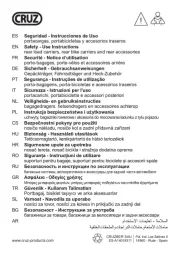
5 Augustus 2025
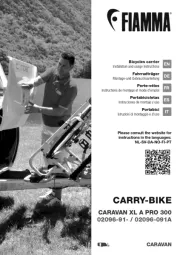
29 Juli 2025
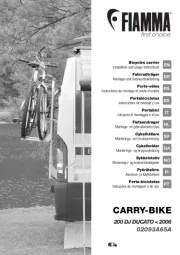
29 Juli 2025
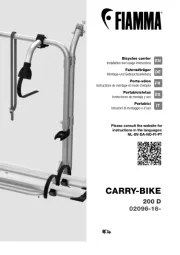
30 Juni 2025

31 Maart 2025
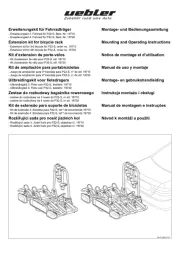
30 November 2024

30 November 2024

16 November 2024

16 November 2024

16 November 2024